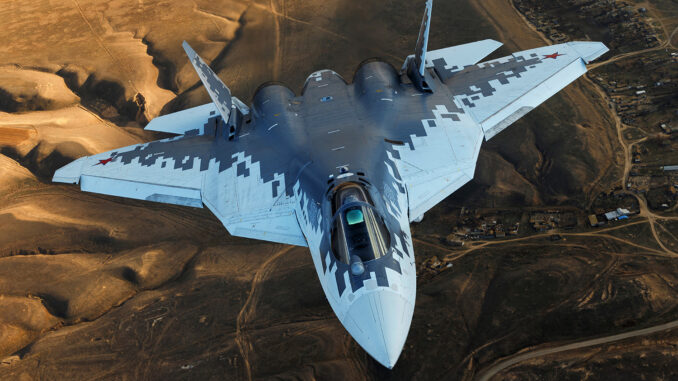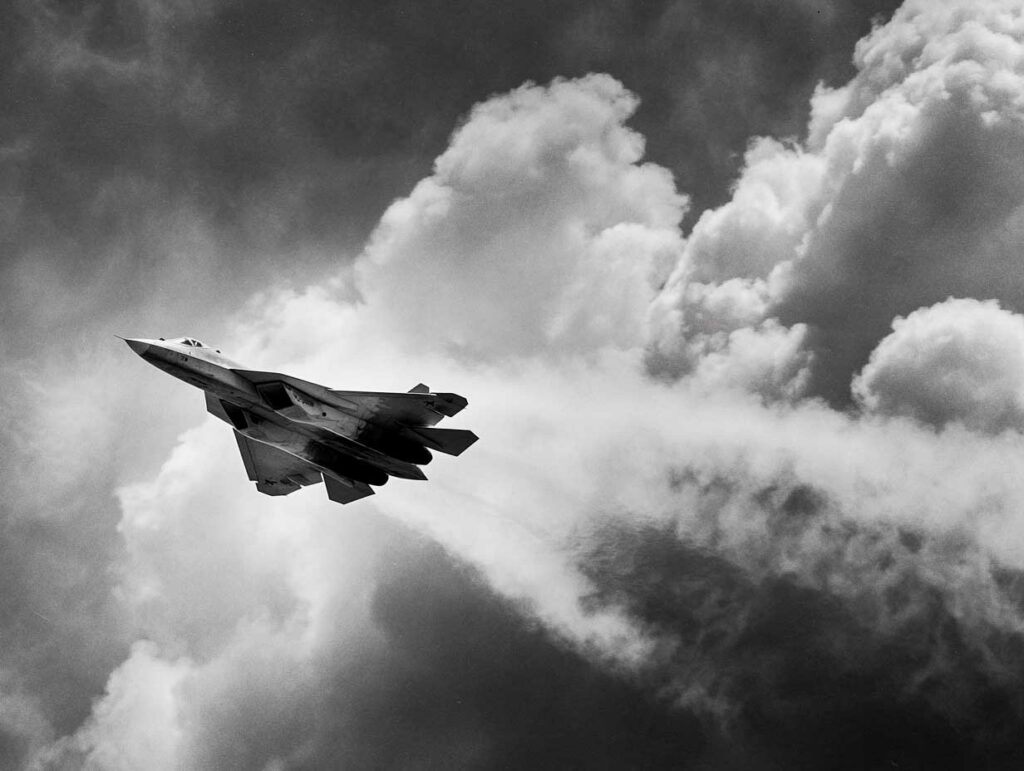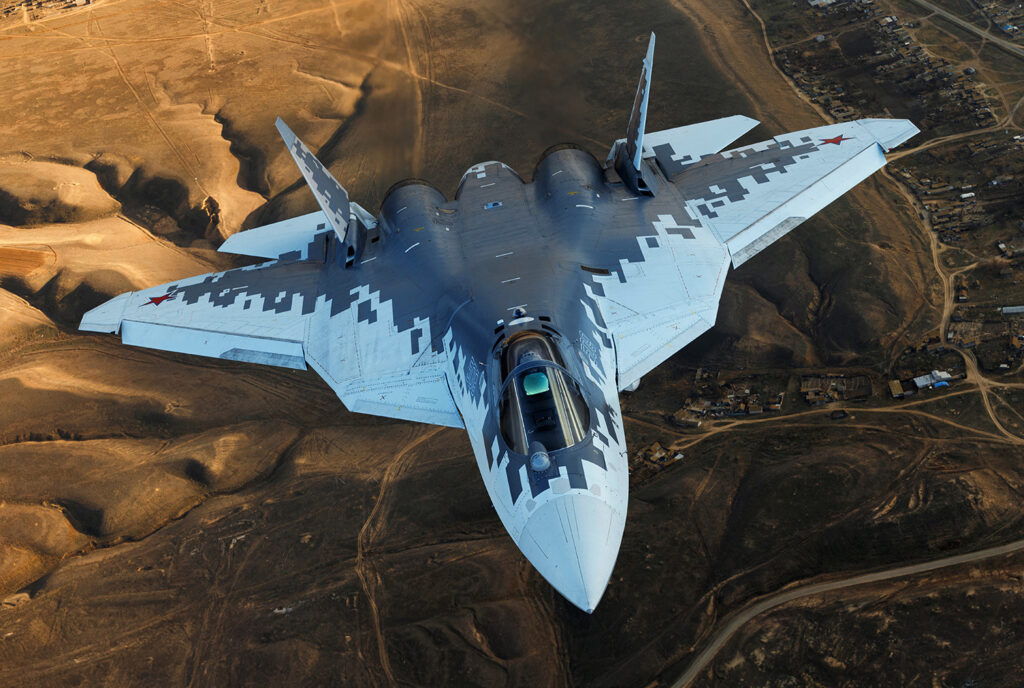
Everything you need to know about the Su-57’s N036 Byelka radar: 2,322 X-band modules, L-band radars, tracking of 60 targets, engagement of 16 air-to-air or 4 air-to-ground targets.
The Su-57, a fifth-generation fighter jet developed by Sukhoi for the Russian military, is based on an advanced radar architecture that combines agility, detection power, and electronic warfare capabilities. At the heart of this system is the N036 “Byelka” AESA radar, integrated into the MIRES Sh-121 suite. This configuration is based on a multi-antenna approach using the X band for active detection and the L band for electronic warfare and friend/foe identification. The front radar has 1,514 transmitter/receiver (T/R) modules, supplemented by two side sensors with 404 modules each. In total, the system uses 2,322 modules, representing a very high density. The aircraft can track up to 60 targets and engage 16 simultaneously in air-to-air combat, or four in air-to-ground mode. This system puts the Su-57 at a competitive technological level with Western aircraft of the same generation, thanks in particular to its extended radar coverage, complete sensor fusion, and design optimized for combat in highly contested environments.

The multi-antenna architecture of the MIRES Sh-121 system
The N036 “Byelka” radar is an integral part of the MIRES Sh-121 system developed by NIIP Tikhomirov. Unlike conventional single-antenna radars, it is based on a structure distributed over several points on the fuselage to widen the detection field and limit blind spots. The main front antenna, N036-1-01, is integrated into the nose of the aircraft. It operates in the X band (frequencies from 8 to 12 GHz) and has 1,514 active transmitter/receiver modules, each capable of processing signals independently.
This main antenna is supported by two N036B-1-01 side sensors, located on the front edges of the fuselage, near the air intakes. Each of these sensors incorporates 404 T/R modules, also in the X band. Thanks to this configuration, the Su-57’s radar system achieves 270° angular coverage, compared to approximately 120° for a conventional front-mounted AESA radar. This allows the aircraft to detect, track, and engage targets that are not only in the flight path.
In addition to these X-band antennas, two L-band sensors (designated N036L-1-01) are installed in the leading edges of the wings. These antennas have two major functions: friend or foe identification (IFF) and long-range radar detection of low-observable targets. L-band waves, with longer wavelengths (1 to 2 GHz), are less sensitive to stealth shapes optimized for the X-band, thereby increasing the probability of detecting low-observable aircraft.
The entire system is controlled by an onboard software suite, which includes two redundant computers: the Solo-21 and the N036YeVS. These units process data from the various sensors in real time, fuse radar, infrared (using the 101KS Atoll system) and electromagnetic information, and transmit a complete view of the environment to the pilot via multifunction displays and a head-mounted display (HMDS).
The tracking and engagement capabilities of the Byelka radar
The N036 can track up to 60 targets simultaneously, with sufficient accuracy to differentiate between compact groups or drone formations. In air-to-air mode, it allows for the active engagement of 16 targets in parallel, in coordination with the Su-57’s fire control systems. In air-to-ground mode, it can engage up to four ground targets, whether mobile or stationary. This level of performance is based on the parallel processing capacity of the T/R modules, as well as on the priority management algorithm developed by the NIIP Institute.
The exact range of the radar remains confidential, but estimates suggest a detection range of over 400 kilometers for an airliner-type target and approximately 120 to 150 kilometers for a stealth target the size of an F-35, depending on the angle of approach. These figures are compatible with fifth-generation AESA specifications and enable the Su-57 to anticipate and launch attacks beyond visual range (BVR), with precise radar guidance to R-77M or R-37M missiles.
The radar system is integrated into electronic warfare via the L402 “Himalayas,” developed by KNIRTI. It uses some of the N036’s antennas to transmit radar countermeasures and jam enemy systems. This dual passive and active use is a major asset for operations in contested environments, where the enemy uses multi-frequency radars.

Operational advantages and limitations of the radar system
The Su-57’s multi-antenna configuration allows it to perform complex tactical maneuvers, such as oblique approaches or side turns, while maintaining radar lock on a target. For example, the pilot can engage a target while positioning himself at a 90° angle to it, reducing his own radar signature and increasing his chances of evasion. This technique, known as “beaming,” is made possible by the N036’s side sensors.
The simultaneous use of X and L bands increases the probability of detecting Western stealth aircraft, which are designed primarily to evade X-band radars. By detecting a target in the L band, even without precise location, the Su-57 can direct its infrared sensors to the relevant area to visually confirm the presence of a threat. This multi-sensor fusion gives the pilot superior tactical awareness.
However, several limitations remain. First, industrial production of the N036 radar remains constrained. To date, Russia has delivered only a limited number of Su-57s in full configuration. Technology sanctions have affected the supply chain for semiconductors for T/R modules, and exports to countries such as India and Algeria are on hold. Second, the long-term reliability of the radar, particularly in severe weather conditions, remains poorly documented.
Another question mark concerns the integration of the radar into an information-centric warfare network. Unlike Western systems such as the F-35, which have a secure digital network with other platforms, the Su-57 currently operates in a more isolated mode, although integration into the Russian C4ISR system is planned.
The N036 “Byelka” AESA radar represents a significant advance for Russian military aviation. With 2,322 active modules distributed across three X-band antennas and two L-band sensors, it offers extended radar coverage and competitive tracking and engagement performance. Its integrated electronic warfare capabilities, multiband processing, and fusion with infrared sensors make it well suited for modern combat. However, its operational deployment remains limited and depends on the Russian industry’s ability to ensure stable, reliable, and interoperable production in a challenging technological environment. The future of the Su-57 as an integrated combat system will depend largely on the maturity of this radar suite and its ability to evolve in line with international standards.
War Wings Daily is an independant magazine.